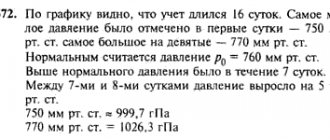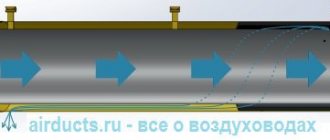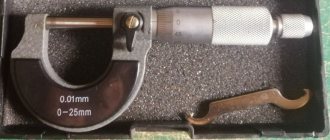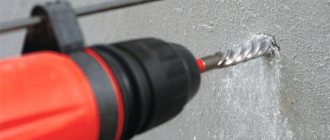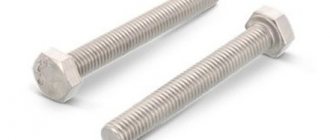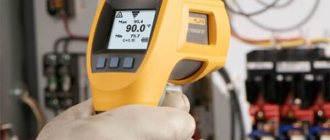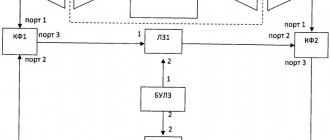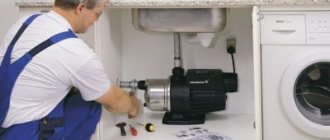Precision is paramount | 03/30/2016
An anemometer, unlike other meteorological instruments - a thermometer and a barometer, has not yet become widespread. Although many people know that the prefix “meter” means some kind of measuring device. But not everyone can explain what physical quantity it measures. Today we will try to figure out why this exotic device is used.
Purpose of the tool
An anemometer is a device for measuring wind speed, translated from ancient Greek - “wind meter” . But the Greeks have nothing to do with it, since the device was invented by the Irish astronomer John Robinson in the mid-19th century. The purpose of the invention was to determine the force, or scientifically speaking, the speed of the wind. Today it is used in various sectors of the economy:
- At meteorological stations that monitor the weather, the results of which sometimes result in storm warnings.
- In airfield flight safety services.
- During the operation of ventilation systems and air conditioning stations of industrial facilities, metro tunnels.
- To control the ventilation of tunneling drifts used in the mining and coal mining industries.
- In the construction industry. A spinner installed on a tower crane, if the permissible wind load is exceeded, warns the operator of the danger using a light and sound signal.
- Workers in the agricultural industry use an anemometer when pollinating crops with fertilizers and chemical plant protection products.
- It is used in some sports involving the use of wind power: paragliding, sailing regattas, ice boat racing, and so on.
Settings
It is better to adjust the anemometer according to the readings of the standard one. But in the absence of one, you can use the following method. Having secured the device to a wooden handle, when the car is moving in a calm state, check the readings of the device with the speedometer of the car. Having selected the value of the wheel radius in millimeters, we set up the device.
By connecting a vertically mounted anemometer to a bicycle computer, we obtain measurement results
Principle of operation
To measure air flow speed and present it in a user-friendly form, the measuring tool contains three building blocks:
- Primary (measuring) block. With the help of an air flow, a disturbing effect is created on one or another physical parameter (rotation, cooling of a heated body, reflection of ultrasound, laser radiation and some others).
- Converter. A changing physical parameter modulates one of the types of energy: mechanical, pneumatic, electrical, electromagnetic, and so on.
- Recording device. The result is displayed using a mechanical revolution counter, a scale with an arrow, a digital indicator, and a display.
The operating principle of measuring sensors determines the following classification of anemometers:
- rotating (cup, blade, spiral);
- heating (thermal);
- ultrasonic (acoustic);
- optical (laser, Doppler);
- dynamic or pressure (based on a Pitot-Prandtl tube);
- vortex;
- float
Classification
The device for measuring wind speed has a sensor in its structure that is in direct contact with the air flow. Depending on the type of this sensor, the following types of anemometers are distinguished:
- Rotating, in which individual structural elements begin to rotate under the influence of wind speed.
- Ultrasonic, which is also called acoustic.
- Heating, they are also called thermal.
- Optical, which in turn are divided into laser and Doppler.
- Dynamic, whose operating principle is based on a Pitot-Prandtl tube.
- Float
- Vortex.
This is a list of devices that can be found currently.
Cup anemometers
3 or 4 hemispherical cups, mounted on an axis using connecting spokes, serve as a sensitive organ. The air flow acts on the cups with different forces (the convex part flows around, and the concave part provides resistance), as a result the system receives a rotational impulse.
A hand-held mechanical anemometer is equipped with several cups. The dial is a revolution counter with three scales: units, hundreds and thousands. The linear speed of the cups does not match the air flow speed. The anemometer coefficient (the reciprocal of the ratio of flow and cup velocities) is in the range from two to three units. In addition, the characteristics of the device are nonlinear. In this regard, to use the device, a calibration graph and a stopwatch are required. Measurement procedure: record the number of revolutions over a certain time interval, use the graph to find the distance traveled by the air flow and divide it by the measurement time. The desired wind speed is obtained, and it is the average speed over this period of time. Measuring range: 1–20 m/s.
The handheld induction anemometer has 3 cups, which increases the torque element of the device and increases the speed of response to changes in wind speed. This device has no additional graphs, and there is no need to record time either, since the measurement is carried out in real time. As the flow rate increases, the induction coil spins a spring-loaded scale that shows the instantaneous flow rate. The measuring range is in the range from 0.2 to 30 m/s.
How to choose correctly
Anemometers are selected according to the purpose of use. The most important parameter is the speed measurement limit. For the installation of air conditioning systems, a unit with a design interval of 0-10 m/sec is suitable, but in the process of designing ventilation systems in production and large retail areas, one cannot do without an anemometer with a range of 0-20 m/sec.
Considering the catalog of digital anemometers, a special place among them is occupied by models with the ability to measure temperature. In warm regions and areas with a mild climate, equipment that records positive temperatures can be used. And in areas with harsh climates, devices that measure parameters from -20 degrees will be required.
Size also matters a lot. For example, for measurements in a ventilation grille, preference is given to wing-type devices with a large, up to 10 cm, diameter at the blades. And for use in an air duct, you will need more compact models with a diameter of no more than 2.5 cm. They are useful when measuring low-velocity flows.
Lobed
In this device, the influence of wind is perceived by a blade impeller. Its operating principle is similar to the cup device. Due to the fact that the axis of rotation of the impeller is parallel to the air flow, the mechanical counter of the hand tool is located in close proximity to the blades (at the rear). Therefore, it is some kind of obstacle to the wind, which limits the operating range. A hand-held paddle anemometer can measure average wind speeds not exceeding 5 m/s.
The digital vane anemometer does not have a mechanical revolution counter that prevents air movement, so the flow speed measured by the device reaches 45 m/s. In this case, the paddle sensor can be built-in or remote. It is possible to measure average, maximum and minimum speed.
Basic operating principle
Working principle of cup anemometer:
- The wind acts on an axis with 3 or 4 cups (hemispheres), rotation occurs and the mechanism for counting the number of revolutions is started.
- The result is displayed on the counter, dial scale or display (depending on the type and modification of the device).
- The resulting number is divided by the device coefficient (2 or 3).
When using a hand-held cup anemometer, you should follow the instructions: measure the duration of the measurement time, and also count the number of axis revolutions, after which the distance traveled by the air flows is noted on the graph. The final result is the specified distance divided by the time it was measured.
Ultrasonic
The principle of operation is based on changing the speed of sound vibrations in a moving air environment. If the moving air flow is directed towards the ultrasound source, the speed of the latter decreases. Conversely, moving in the same direction as sound, the flow increases its speed. Thus, by controlling the time of receipt of the ultrasonic pulse reflected from the air, it is possible to determine the flow speed. Ultrasonic devices are connected to a meteorological data processing unit, and the results are output to a personal computer. Sensors vary in the number of measurements they perform:
- Two-dimensional. The direction of flow and its speed are measured.
- Three-dimensional. 3 speed vectors are determined.
- Thermal anemometers (4-dimensional). Such an anemometer is a device for measuring not only 3 speed components, but also ambient air temperature.
The absence of moving elements allows the acoustic device to measure wind speeds of up to 60 m/s.
Operating principle
Despite the variety of anemometers, which differ in design, most of them work on the principle of determining the nature of the action of air flow on moving rotating elements. Instruments in this category are capable of determining the maximum current wind speed when the flow is blowing in a certain direction. Some models provide indicators of volumetric air flow, flow temperature, and humidity. Thus, a functional instrument for measuring wind speed turns into a portable weather station.
Thermal or thermal
It is known that in hot weather a fresh breeze pleasantly cools the skin. And these are not subjective feelings, but a real fact. The operation of thermal anemometers is based on this principle. The sensitive element of this device is a thread made of a refractory material through which an electric current is passed. The conductor heats up to a higher temperature than the surrounding environment. The blowing air cools the conductor, as a result of which its resistance changes. There are 3 sensor connection schemes:
- with a fixed current value;
- with constant voltage;
- thermal constant connection.
This design is used in the mass air flow sensor (MAF), which is equipped with all modern car engines.
Anemometer - translation into Russian - examples English | reverso context
Nothing found for this value.
Results: 19. Exact matches: 19. Time spent: 19 ms Documents Corporate solutions Conjugation Synonyms Corrector Help and about us
Word index:1-300, 301-600, 601-900
Expression Index:1-400, 401-800, 801-1200
Phrase index:1-400, 401-800, 801-1200
About the context dictionaryDownload the applicationContactsLegal issuesPrivacy settings
© 2021-2021 Reverso Technologies Inc. All rights reserved.
Choosing an inexpensive anemometer
People who are keen on extreme recreation sometimes need a mobile weather assistant. Not everyone wants to make complex manipulations with written calculations to determine wind speed. Modern digital devices will do this by pressing just one button, such as the SKYWATCH Xplorer 1 sports anemometer. The pocket-sized device with a paddle sensor weighs 50 g. Measuring range: 0.5–42 m/s. Determines the current wind speed with fixation of its maximum value. It has a backlit screen and runs on a lithium battery. Withstands short-term immersion in water. The manufacturer's brand is the Swiss company JDC Electronic, the price is about four thousand rubles.
Welding cable. Price per meter
Renovator. User reviews
Installation
We install the device on a high pole on the roof of the house. We calculate what we will do and in what sequence, prepare materials and tools. It is fashionable to make a basting without a device, and then install it. We run the cable into the house and turn on the device. You can see how it works in the video.
Thus, we know how to make an anemometer with your own hands and what is needed for this. It doesn’t matter what the device is used for - ventilation, speed or temperature measurement. It doesn’t matter what it is - stationary, miniature or induction. One thing is for sure - it brings benefits to people.
Thermal anemometer
Thermal anemometer combines the functions of two devices
The principle of operation of a hot-wire anemometer is the same as that of all acoustic devices - it measures the speed of sound, and then, based on this data, transmits information about wind speed. This device is electronic and is used more often than the first two; besides, it, working on the principle of an acoustic temperature sensor, shows the air temperature. This is an ultrasonic anemometer and its design is quite complex. Therefore, it is used to control the microclimate at workplaces in various industrial sectors. There are many types of portable digital thermal anemometers on sale - dough anemometer, etc.
In addition to the three described above, the so-called manual induction anemometer “ARI-49” is produced. An electric meter is built into it (Figure “c”).


